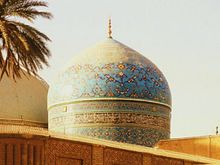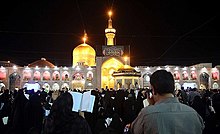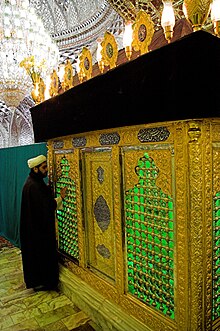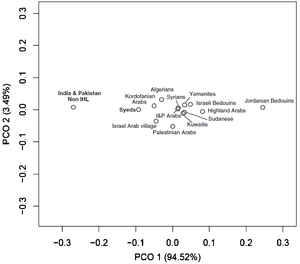Sayyid
| Part of a series on Islam |
| Usul al-Fiqh |
|---|
| Fiqh |
| Ahkam |
| Legal vocations and titles |
|
| Part of a series on Sunni Islam |
|---|
|
|
| Part of a series on Shia Islam |
| Twelver Shi'ism |
|---|
|
|

Sayyid
Along with
Etymology
A few
In the Arab world, sayyid is the equivalent of the English word "liege lord" or "master" when referring to a descendant of Muhammad, as for example in Sayyid Ali Sultan.[16][17]
Origin of the title
The foundation of the title Sayyid is unclear. In fact the title Sayyid as a unified reference for descendants of Muhammad did not exist according to Monimoto until the Mongol conquests.[18] This can be substantiated by historic records about Abdul Qadir Gilani and Bahauddin Naqshband, who did not refer to themselves with any title, despite their lineages to Muhammad. Sometimes the ruling community of a nation, took this title to portray themselves as respected and honored, though they are not actually the descendants of Muhammad. This gives reasons to think that this title is founded later on. Monimoto refers to Mominov, who describes that the emergence of a community leader during the Mongol era (Ilkhanate) gave rise to the prominence of the title Sayyid.[19] This leader is most probably the Sunni Shafiite scholar Mir Sayyid Ali Hamadani, who lived in this time, being known as a saint credited with the honorific titles "Amir-e-Kabir"(English: Grand Prince) and "Ali-e-Saani" (English: Second Ali).[20] Hamadani's religious legacy in Kashmir as well as his headquarter (Persian: Khanqah) the Khanqa-e-Mola became under the control of the Grand Sayyid Hazrat Ishaan. Hazrat Ishaan's descendants are buried in Hamadani's headquarter, on which occasion it is known as the Ziyarat Naqshband Sahab today.[21][22][23]
However in
In
Statistics
Although reliable statistics are unavailable, conservative estimates put the number of Sayyids in the tens of millions.[27]
Traditions
Traditionally,
Other indication of descent
In addition to the sayyid title, descendants of Muhammad through the Twelve Imams in Arabic, Persian and Urdu may obtain the following surnames:[32]
| Ancestor | Arabic style | Arabic last name | Persian last name | Urdu last name |
|---|---|---|---|---|
Ali ibn Abi Talib |
al-Alawi العلوی او الهاشمی | al-Alawi العلوی
al-Hashimi الهاشمي |
Alavi, or Alawi |
Alvi or Hashimi or Awan or Hashemi |
| Hasan ibn Ali | al-Hasani الحسني او الهاشمي | al-Hasani الحسني al-Alawi العلوی
al-Hashimi الهاشمي |
Hashemi هاشمی
Hassani حسنى |
Hashmi ہاشمی or
Hassani حسنی Noshahi نوشاہی |
| Husayn ibn Ali | al-Hussaini1 الحُسيني | al-Hussaini الحسيني | Hussaini حسيني |
|
Ali ibn Husayn Zayn al-Abidin |
al-Abidi العابدي | al-Abidi العابدي | Abedi عابدى | Abidi or Abdi عابدی |
| Muhammad al-Baqir | al-Baqiri الباقري | al-Baqiri الباقري | Baqiri باقری | Baqri باقری |
| Ja'far al-Sadiq | al-Ja'fari الجعفري | al-Ja'fari or al-Sadiq/Sadegh الصدق او الجعفري | Jafari or Sadeghi جعفرى/ صادقی or Dibaji/Dibaj دیباج/دیباجی |
Jafri or Jafry جعفری or Jaffery shamsi جعفریشمسی
|
| Zayd ibn Ali | az-Zaidi الزيدي | al-Zaydi الزيدي | Zaydi زیدی | Zaidi زیدی |
Musa al-Kadhim |
al-Moussawi الموسوي او الكاظمي | al-Moussawi or al-Kadhimi الموسوي او الكاظمي | Moosavi or Kazemi موسوى / کاظمى |
Kazmi کاظمی |
Ali al-Ridha |
ar-Radawi الرضوي | al-Ridawi or al-Radawi الرضوي | Rizvi or Rezavi رضوى | Rizvi or Rizavi رضوی |
| Muhammad at-Taqi | at-Taqawi التقوي | al-Taqawi التقوي | Taqavi تقوى | Taqvi تقوی |
| Ali al-Hadi | an-Naqawi النقوي | al-Naqawi النقوي or al-Bukhari البخاري or al-Qasimi القاسمی | Naghavi نقوى | Naqvi نقوی or Bhaakri/Bukhari بھاکری/بخاری
|
| Hasan al-Askari[34][35][36] | al-Askari العسکري | al-Askari العسکري | Sadat سادات Dakik دقيق or Hazrat Ishaan حضرت ایشان | Dakik دقيق or Hazrat Ishaan حضرت ایشان |
Note: (For non-Arabic speakers) When transliterating Arabic words into English there are two approaches.
1Also, El-Husseini, Al-Husseini, Husseini, and Hussaini. 2Those who use the term Sayyid for all descendants of Ali ibn Abi Talib regard | ||||
Some Sayyids are Najeeb Al Tarfayn, meaning "Noble on both sides", which indicates that both of their parents are Sayyid.
Existence of descendants of Hasan al-Askari
The existence of any descendant of

These Central Asian notable sayyid families have historical genealogical manuscripts that are confirmed with seals by many Naqibs, Muftis, Imams, Kadi Kuzzats, A’lams, Khans, and Emirs of those times. One descendant of Sayyid Ali Akbar was Saint Ishan (Eshon) Imlo of Bukhara.
In her book Pain and Grace: A Study of Two Mystical Writers of Eighteenth-Century Muslim India, Dr. Annemarie Schimmel writes:
Khwaja Mir Dard's family, like many nobles, from Bukhara; led their pedigree back to Baha'uddin Naqshband, after whom the Naqshbandi order is named, and who was a descendant, in the 11th generation of the 11th Shia imam al-Hasan al-Askari.[57]
Although Shiite historians generally reject the claim that Hasan al-Askari fathered children other than Muhammad al-Mahdi, Bab Mawlid Abi Muhammad al-Hasan writes, in the Shiite hadith book Usul al-Kafi:
When the caliph got news of Hasan 'Askari's illness, he instructed his agents to keep a constant watch over the house of the Imam...he sent some of these midwives to examine the slave girls of the Imam to determine if they were pregnant. If a woman was found pregnant she was detained and imprisoned....[34][58][59][60][61][62]
Middle East
Men belonging to the Sayyid families or tribes in the Arab world used to wear white or ivory coloured daggers like jambiyas, khanjars or shibriyas to demarcate their nobility amongst other Arab men, although this custom has been restricted due to the local laws of the variously divided Arab countries.
Iraq


The Sayyid families in Iraq are so numerous that there are books written especially to list the families and connect their trees. Some of these families are: the Alyassiri, Al Aqeeqi, Al-Nasrullah, Al-Wahab,
Iran


Sayyids (in
During the reign of
Common Sayyid family surnames in Iran are
Bahrain
In
Oman
In Oman, Sayyid is used solely as a royal title and not as a means of indicating descent from Muhammad. It is used by members of the ruling Al Said family who are not descended from Muhammad but instead from the Azd, a Qahtanite tribe. All male line descendants of Sultan Ahmad bin Said, the first ruler of Oman from the Al Said dynasty, are able to use the title of Sayyid or Sayyida.[74] Male line descendants of Sultan Turki bin Said are also able to use the style of His/Her Highness. The Sayyid title in Oman is some times translated as Prince.[75]
Yemen
In Yemen the Sayyids are more generally known as sadah; they are also referred to as
South Asia


In South Asia, Sayyids are mostly credited for preaching and consolidating the religion of Islam. They are predominantly descendants of leading saints of Sunni faith that migrated from Persia to preach Islam of which the Persian Sayyid Moinuddin Chishti has set the cornerstone. Thus Moinuddin Chishti is regarded as Sultan-i-Hindustan in Islamic Theology.[79][80] The following saints and their descendants are most well known:
- Bulleh Shah
- Sayyid Haji Muhammad Noshah Ganj Baksh Qadiri
- Sayyid Abdul Latif Shah, known as Bari Imam Sarkar
- Mir Sayyid Ali Hamadani
- Sayyid Jalaluddin Surkh Posh Bukhari
- Sayyid Awn Qutb Shah Wali
- Sayyid Abdul Wahab Gilani, son of Sayyid Abdul Qadir Gilani
- Sayyid Musa Pak Shaheed (ancestor of Yusuf Raza Gillani) and Sayyid Habeeb Shah Gilani (Teacher of Sultan Bahoo)
- Sayyid Moinuddin Chishti
- Sayyid Imam Ali Shah Qalandar
- Lal Shahbaz Qalandar
- Sayyid Badiuddin Zinda Shah Madar
- Bahauddin Naqshband
- Hazrat Ishaan
- Moinuddin Hadi Naqshband
- Sayyid Mir Jan
- Sayyid Mahmud Agha
- Sayyid Mir Fazlullah Agha
- Tajuddin Muhammad Badruddin
- Pir Baba
- Shaal Pir Baba
- Maudood Chishti
- Wali Kirani
- Khwaja Abdullah Chishti
- Ibrahim Yukpasi
- Shah Sayyid Nasruddin
- Sayyid Masud Al-Hussaini
- Syed Shah Sadaruddin Lakyari
North India
The earliest migration of Sayyids from Afghanistan to
Sayyids of Syed nagli, or Said Nagli, or the Baquari Syeds had migrated from
Perhaps the most important figure in the history of the Sayyid in Uttar Pradesh was Sayyid Basrullah Shustari, who moved from
Uttar Pradesh
The ancestor of the Bārha Sayyids, Sayyid Abu'l Farah Al Hussaini Al Wasti, left his original home in
The Sayyeds of
The Sayyids of Bilgram are Hussaini Sayyids, who first migrated from Wasit, Iraq, in the 13th century.[96] Their ancestor, Syed Mohammad Sughra, a Zaidi Sayyid of Iraq, arrived in India during the rule of Sultan Iltutmish. In 1217–18 the family conquered and settled in Bilgram.[97]
A notable Sufi that belonged to a Sayyid family was Syed Salar Masud, from whom many of the Sayyid families of
Sadaat also found in
Bihar
There are different families of syeds in Bihar who belong to direct descendent of Imam Hasan and Imam Hussain. Mostly there are Hussaini (Rizvi, Zaidi, Baqri) along with Hasani (Malik, Quadri or Geelani). Sadaat are settle in different part of bihar including shia and sunni sects. They are mostly migrated to bihar from Iraq and Iran.
The Hasibs from the Sadaat e Rajhat clan are descended from Syed Yaqub Halabi also known as Syed Yaqub Baghdadi, a Hanafi Qazi from Madrassa
Zaidi Sadaat of Bihar are the descendants of Sufi saint Syed Ahmad Jajneri and Syed Mohammed Jajneri. Syed Ahmad Jajneri migrated to India from Baghdad during the reign of
region of Bihar.Most prominent personalities of Sadaat of Bihar were from Desna, Bihar. For Example Syed Mohammed Saeed Raza, Abdul Qavi Desnavi[110] and Sulaiman Nadvi.[111][112] Desna's library, established in 1892, had thousands of old Persian and Urdu manuscripts. After the partition of India, during uncertain times of mass emigration to Pakistan, the books were donated to Khuda Bakhsh Khan Library in Patna, where a Desna section was established to house these treasures.[111] Other famous personalities of Bihari Syed were Syed Sultan Ahmed, Syed Hasan Imam and Sir Imam Ali .
Kerala
In Kerala, a number of Sayyid families (Qabila) are found. Most of them migrated from Arabian peninsula (Yemen's
Sayyids occupy various postions as jurists (qazi), scholars (ulama') and leaders (umara'). The state leaders of
Sayyid members in Kerala
- Sayyid Ali (18th century)
- Sayyid Hussain ibn Muhlar (1812–1882)
- P. M. S. A. Pukkoya Thangal (died 1975)
- Sayyid Muhammedali Shihab Thangal
- Sayyid Hyderali Shihab Thangal (1947–2022)
- Sayyid Sadiq Ali Shihab Thangal (born 1964)
- Sayed Abbas Ali Shihab Thangal (born 31 May 1971)
Genetic studies and controversy of self-proclaimed Indian Sayyids

The authors of the study, the Y chromosomes of self-identified Syeds from the Indian sub-continent are no less diverse than those non-Syeds from the same regions, suggested that Syed status showed evidence of elevated Arab ancestry but not of a recent common patrilineal origin.[115]
In
The paper, "Y chromosomes of self-identified Syeds from the Indian subcontinent", by Elise M. S. Belle, Saima Shah, Tudor Parfitt, and Mark G. Thomas showed that "self-identified Syeds had no less genetic diversity than those non-Syeds from the same regions, suggesting that there is no biological basis to the belief that self-identified Syeds in this part of the world share a recent common ancestry. However, self-identified men belonging to the IHL (Syeds, Hashemites, Quraysh and Ansari) show greater genetic affinity to Arab populations—despite the geographic distance, than other Indian populations.[117]
Southeast Asia
Most of the Alawi Sayyids who moved to
Some common surnames of these Sayyids are Al-Saqqaf (or As-Saqqaf, Assegaf, Assegaff, Al-Sagoff), Shihab (or Shahab), Al-idaroos (or Al-Aydrus, Al Aidrus, Alaydrus, House of Bendahara, House of Temenggong), Al-Habsyi (or Al-Habshi), Al-Kaff, Al-Aththos (or Al-Attas, Alattas, Alattos), Al-Haddad Alhaddad), Al-Jufri (or Al-Jifri), Al-Muhdhar, Al-Shaikh Abubakar, Al-Qadri, Al-Munawwar, Al-Akbar Al-Hasani (or Al Akbar Al Hasani, Al-Bolkiah, House of Bolkiah), Al-Jamalullail (or Al Jamalullail, Djamalullail, House of Jamalullail).[122]
Tesayyud
In the Ottoman Empire, tax breaks for "the People of the House" encouraged many people to buy certificates of descent or forge genealogies; the phenomenon of teseyyüd – falsely claiming noble ancestry – spread across ethnic, class, and religious boundaries. In the 17th century, an Ottoman bureaucrat estimated that there were 300,000 impostors. In 18th-century Anatolia, nearly all upper-class urban people claimed descent from Muhammad.[123][124]
Royal Descendants of Muhammad
Descendants of Muhammad are present in many royal families today and are predominantly of Sunni faith.
Afghan royal family
Within
Iranian Royal Family

Qajar
Within the Qajar Dynasty, the Nizari-Ismaili Imam Agha Khan I married with the daughter of Fath Ali Shah Qajar, bestowing confirmed royalty upon their descendants. Until today Prince Karim Aga Khan and his descendants bear the title Prince, in virtue of his lineage to Fath Ali Shah Qajar.[126][127] However many Sunni Historians deny the descent of the First Fatimid Caliph Ubaidullah al Mahdi-billah to Muhammad. They thus polemically call them Ubaydids instead of Fatimids.[128][129][130][131]
Pahlavi

Within the
GCC Royal families

UAE
The Al Qasimi ruling family that rules over Sharjah and Ras al Khaimah trace their lineage back to Muhammad in the line of the 10th Imam Ali al Hadi.[134][135]
Qatar
Within the Qatari ruling Family, descendants of Muhammad are present within the descendants of the Emir Sheikh Ali ibn Abdullah al Thani on the occasion of intermarriages with the Al Qasimi Dynasty. A UAE Princess from the al Qasimi ruling family, called Sheikha Sheikha bint Muhammad al Qasimi married with Muhammad bin Ali bin Abdullah Al Thani. Together they issued a son who is a Qatari-Sharjan Aviation Statesman called Sheikh Abdullah bin Mohamed. His son is the first descendant of Muhammad to climb Mt. Everest. Another UAE Princess called Sheikha Hind bint Faisal Al Qasimi married Sheikh Abdullah bin Saud al Thani, issuing only one son.[136]
Libyan Royal Family
The Sayyids in Libya are Sunni, including the former royal family, which is
Sherifs of Mecca
Jordan
The Hashemite Royal family of Jordan also claims descent from Muhammad in the line of the Sherifs of Mecca, vassals that were set by the Fatimids and recognized by the Ottomans, tracing their lineage back to Imam Hasan ibn Ali.[138] The Hashemite Royal Family under Sharif Hussein ibn Ali was crucial in ending Ottoman rule in the Arabian Peninsula, on the occasion of the spread of Pan-Turkism in the Arabian Peninsula.[139]
Brunei
The House of Bolkiah claims descent from Imam Hasan ibn Ali through Sharif Ali, the 3rd Sultan of Brunei, who succeeded his father in law as Sultan in virtue of his descent from Muhammad. Sharif Ali formerly served as Emir of Makkah and belonged to the Sherifians, migrating to Brunei for missionary purposes.[140]
Moroccan Royal family
Sulu, Lanao and Maguindanao royal family
The Sultanates of Sulu, Lanao, and Maguindanao hold a significant place in Philippine history, rooted deeply in both cultural heritage and religious identity. It is widely acknowledged that these Sultanates trace their lineage to the esteemed lineage of the Prophet Muhammad ﷺ, upholding the tenets of Sunni Ash'ari in Aqeeda (theological creed) and adhering to the Shafi'i school of thought in Fiqh (jurisprudence). Central to their spiritual and intellectual tradition are the teachings of Sufi missionaries from the Ba 'Alawi sada, whose influence has played a pivotal role in shaping the religious landscape of the region.[142]
The majority of Muslims in the Philippines adhere to the Sunni Ash'ari creed and follow the Shafi'i school of jurisprudence, reflecting the enduring influence of these traditions within the Sultanates and beyond. Furthermore, there exists a profound respect for, and in many cases, the practice of Sufism among Filipino Muslims. Sufism, with its emphasis on spiritual purification and the pursuit of inner knowledge, resonates deeply with the cultural and religious fabric of the Filipino Muslim community.[143]
See also
- Family tree of Muhammad
- Mir Sayyid Ali Hamadani, most probable originator of the title, influencing the Sunni opinion of definition
- Hazrat Ishaan, succeeding Hamadani's clerical legacy
- Mir (Persian Princes of the Sayyids)
- Naqib (Arabian Sheikhs of the Sayyids)
- Safavid Empire, whose clerics influenced the Shiite opinion of definition
- Sadat (disambiguation)
- Mirza (title)
Notes
- ^ Also spelt sayid, said,[6] saiyed, seyit, seyd, syed, sayed, sayyed, saiyid, seyed and seyyed.[citation needed]
References
- ^ Grim, Brian J.; Johnson, Todd M. (2013). Chapter 1: Global Religious Populations, 1910–2010 (PDF) (Report). Wiley. p. 22. Archived from the original (PDF) on 20 October 2013. Retrieved 10 March 2017.
- ^ "What are the top 200 most spoken languages?". Ethnologue. 3 October 2018. Retrieved 7 December 2019.
- ^ Al-Jallad, Ahmad (30 May 2011). "Polygenesis in the Arabic Dialects". Encyclopedia of Arabic Language and Linguistics.
- ^ United Nations High Commissioner for Refugees. "Refworld – 2010 Report on International Religious Freedom – China (includes Tibet, Hong Kong, Macau)". Refworld. Retrieved 14 February 2015.
- SIL Ethnologue
- ^ a b "Sayyid". Collins English Dictionary. HarperCollins. Archived from the original on 28 May 2019. Retrieved 28 May 2019.
- ^ "sayyid" Archived 28 May 2019 at the Wayback Machine (US) and "sayyid". Lexico UK English Dictionary. Oxford University Press. Archived from the original on 22 March 2020.
- ^ "sayyid". The American Heritage Dictionary of the English Language (5th ed.). HarperCollins. Retrieved 28 May 2019.
- ^ Van Arendonk & Graham 1960–2007.
- ^ Parwej, Mohammad Khalid (2015). 365 days with Sahabah. Goodword Books. Retrieved 4 July 2017.
- ISBN 978-0-520-93869-4. Retrieved 25 August 2016.
- ISBN 9780748678310. Archivedfrom the original on 29 July 2017. Retrieved 28 April 2017.
- ISBN 978-9004168589. Archivedfrom the original on 6 October 2014. Retrieved 28 April 2017.
- ^ Lisān Al-'Arab. Retrieved 14 September 2022.
- ^ Wehr, Hans (1976). A Dictionary of Modern Written Arabic. p. 440.
- ISBN 978-0-8133-4980-0. Archivedfrom the original on 15 February 2017. Retrieved 25 August 2016.
- ^ People of India by Herbert Risely
- ^ Morimoto in Sayyids and Sharifs in Muslim Societies, introduction;
- ^ Morimoto in Sayyids and Sharifs in Muslim Societies, introduction, p. 7
- OCLC 65200978. p. 292
- ^ Tazkare Khwanadane Hazrat Eshan(genealogy of the family of Hazrat Eshan)(by author and investigator:Muhammad Yasin Qasvari Naqshbandi company:Edara Talimat Naqshbandiyya Lahore)p. 58
- OCLC 69327348– via Open WorldCat.
- ^ Suraiya Gull in "Development of Sufi Kubraviya Order with Special Reference to Mir Saiyid Ali Hamadani", p. 8
- ^ a b Tazkare Khanwade Hazrat Ishaan, p. 61, by Muhammad Yasin Qaswari Naqshbandi, published by Kooperatis Lahorin, Edare Talimat Naqshbandiyya
- ^ Damurdashi, ed. Muhammad, p. 43.
- ^ Imber and Kiyotaki, p. 198.
- ISBN 978-0-415-51917-5.
Reliable statistics showing the number of the Prophet's kinsfolk, spread all through the Muslim world and far beyond it, are not available. Even a conservative estimate, however, would suggest that the number of kinsfolk is in the tens of millions.
- ^ Goldziher, I. and Boer, Tj. de, "At̲h̲ar", in: Encyclopaedia of Islam, Second Edition, Edited by: P. Bearman, Th. Bianquis, C.E. Bosworth, E. van Donzel, W.P. Heinrichs.
- ^ "Topkapi Web Page". Archived from the original on 13 January 2013. Retrieved 11 June 2018.
- ^ "The 2002 Smithsonian Folklife Festival: Connecting Culture, Creating Trust". Archived from the original on 24 September 2009. Retrieved 11 June 2018.
- ^ "Islamic Picture Gallery - Home > Islamic Relics". Archived from the original on 1 June 2015. Retrieved 11 June 2018.
- ISBN 978-81-8220-062-3.
- ^ "The Syed Family – Home of The Syed Family". Retrieved 5 May 2024.
- ^ a b c d Tazkare Khwanadane Hazrat Eshan(genealogy of the family of Hazrat Eshan)(by author and investigator: Muhammad bin Nusayr company:Edara Talimat Naqshbandiyya Lahore)p. 63
- ^ a b c https://shajara.org/2020/06/29/1426/ Archived 3 July 2020 at the Wayback Machine Shajara-e-nasab lineages of descendants of Imam Hasan al-Askari r.a.
- ^ a b "Shajara-e-nasab lineages of descendants of Imam al-Askari ibn Imam Ali al-Hadi r.a. — Shajara". Archived from the original on 17 April 2021. Retrieved 16 March 2021.
- ^ https://sayyidamiruddin.com/ancestry/ Archived 15 May 2020 at the Wayback Machine Accreditation of Ancestry & Lineage
- ^ "АХЛ аль-БЕЙТ, Имам Махди (да приблизит Аллах его пришествие!) : Ислам в Азербайджане (iSLAM.Az)". 14 April 2012.
- ^ a b page 41 "النجف الأشرف) السيد محمد مهدي ابن السيد محمد اصفهاني الموسوي الكاظمي "دوائر المعارف في الأسماء الحسنى)
- ^ "Dastur al Mulk" (Guide to Kings) (XVII сentury) by Khwaja Samandar Muhammad ibn Baqi al-Termizi, translator professor of history Jabbor Esonov, "Sharq", Tashkent 2001, page 22
- ^ "Durdonahoi Nasr" book, "Adib", Dushanbe 1985, page 375
- ^ "Sayyidlar Shajarasi", "Islamic university", Tashkent 2017, page 14
- ^ "Sulton Sodot Amir Sayyid Ali Akbar". Shajara. Archived from the original on 26 March 2023. Retrieved 2 November 2023.
- ^ «Buyuk Termiziylar» (Буюк Термизийлар) book by Mirzo Kenjabek, "Uzbekistan National encyclopedias" 2017, page-267
- ^ Sheikh Qumi, Muntahi al-Amal, 1379, chapter-3, p-20
- ^ Hossein Madani, book "Tuhfat al-Azhar", Al-Tarat al-Maktub, chapter-1, pp-9-10
- ^ Kharz ad-din, book "Markat al-Maarif", 1371, chapter-2, pp-242
- ^ Badawi, Saba al-Jazeera, book Saba al-Dujail Information and Guidance Centre, p-10
- ^ Naqib al-Ashraf Ibn Abd al-Ahad Sherazi "Shajara-e-nasab", p-27-39, Islamic University, Association of Naqabats,2012
- ^ »ЭШОН ИМЛО БУХОРИЙ Archived 9 January 2017 at the Wayback Machine.
- ^ a b https://shajara.org/2020/06/29/%d1%8d%d1%88%d0%be%d0%bd-%d0%b8%d0%bc%d0%bb%d0%be-%d0%b1%d1%83%d1%85%d0%be%d1%80%d0%b8%d0%b9-%d2%b3%d0%b0%d0%b7%d1%80%d0%b0%d1%82%d0%bb%d0%b0%d1%80%d0%b8%d0%bd%d0%b8%d0%bd%d0%b3-%d1%88%d0%b0%d0%b6/ Archived 30 June 2020 at the Wayback Machine Эшон Имло Бухорий ҳазратларининг шажараси ҳақида
- ^ https://shajara.org/2020/06/29/naqshbandiya-shajarasi-izidan/ Archived 30 June 2020 at the Wayback Machine NAQSHBANDİYA SHAJARASİ İZİDAN
- ^ "Maqolalar". shajara.info. Archived from the original on 3 August 2017.
- ^ "Tasavvuf Ahli". shajara.info. Archived from the original on 3 August 2017.
- ^ "Ishtixonning so'nggi qozisi Qozi Sayyid Bahodirxon -". Türkistan Seyyidler ve Şerifler derneği (Turkestan Sayyid and Sheriffs Association). Archived from the original on 8 August 2016.
- ^ https://shajara.org/2020/06/24/qozi-sayyid-bahodirxon-ibn-sayyid-ibrohimxoja/ Archived 30 June 2020 at the Wayback Machine Qozi Sayyid Bahodirxon ibn Sayyid Ibrohimxo’ja
- ^ Dr.Annemarie Schimmels book «Pain and Grace: A Study of Two Mystical Writers of Eighteenth-Century Muslim India» BRILL, 1976, p.32
- ^ al-Kafi, by Muhammad Ya'qub Kulayni. Translated by Muhammad Sarwar. Chap. 124, Birth of Abi Muhammad al-Hasan ibn 'Ali, p.705
- ^ Dr.Annemarie Schimmels book "Pain and Grace: A Study of Two Mystical Writers of Eighteenth-Century Muslim India" BRILL, 1976, p.32
- ^ "Gulzar Auliya: Hadhrat Khwaja Bahauddin Naqshband ZiaIslamic". Abu Hanifa Welfare and Education Trust / Abul Hasanaat Islamic Research Center. Archived from the original on 22 October 2016. Retrieved 22 September 2016.
- ^ "Bloodline & Family Lineage". 24 April 2011. Archived from the original on 2 February 2017.
- ^ "Pokistondagi Sayyidlar Sulolasi". Archived from the original on 19 January 2017.
- ^ Reclaiming Iraq: The 1920 Revolution and the Founding of the Modern State Archived 30 April 2016 at the Wayback Machine By Abbas Kadhim
- ^ البغداديون أخبارهم ومجالسهم By إبراهيم عبد الغني الدروبي - مطبعة الرابطة - Baghdad 1958 – مجلس آل الوتري (House of Al-Witry Council) - Page 78.
- ISBN 9953-441-51-0
- ^ Six million people of Iran's population are Sadaat (Sayyid) / Tehran and Mazandaran (provinces) are the record owner of Sadaats in the country Archived 2 February 2018 at the Wayback Machine farsnews.ir1 February 2018
- ISBN 978-1-78076-990-5. Archivedfrom the original on 3 September 2017.
In fact, at the start of the Safavid period Twelver Shi'ism was imported into Iran largely from Syria and Mount Lebanon (...)
- ^ a b The failure of political Islam, by Olivier Roy, Carol Volk, pg.170
- ^ a b The Cambridge illustrated history of the Islamic world, by Francis Robinson, pg.72
- ^ a b The Middle East and Islamic world reader, by Marvin E. Gettleman, Stuart Schaar, pg.42
- ^ a b The Encyclopedia of world history: ancient, medieval, and modern ... by Peter N. Stearns, William Leonard Langer, pg.360
- ISBN 9780231144261. Archivedfrom the original on 29 July 2017. Retrieved 15 November 2015 – via Google Books.
- ISBN 9781847999429– via Google Books.
- ^ Razik, Salil (1871). Badger, George Percy (ed.). History of the imâms and seyyids of Omân. The Hakluyt Society. p. 377.
- ISBN 978-0-85011-029-6.
- ^ A Tribal Order: Politics And Law in the Mountains of Yemen Archived 17 June 2016 at the Wayback Machine By Shelagh Weir
- ^ "sayyid – Arabic title". Encyclopædia Britannica. Archived from the original on 22 January 2012.
- ^ From Religious Leaders to Ordinary Citizens The Changing Role of "Sadah" in Yemen Archived 26 October 2012 at the Wayback Machine By Mohammed Al-Asadi
- ^ Mohammada in The Foundations of the Composite Culture in India, p. 170
- ^ Wani in Islam in Kashmir Fourteenth to Sixteenth Century, p. 147
- ^ "Data". www.myheritage.com. Archived from the original on 28 January 2016. Retrieved 8 January 2020.
- ISBN 9780415519175. Archivedfrom the original on 3 September 2017. Retrieved 15 November 2015 – via Google Books.
- ISBN 978-9004231870. Archivedfrom the original on 3 September 2017. Retrieved 21 June 2016 – via Google Books.
- ^ a b People of India Uttar Pradesh Volume XLII Part Three, edited by A Hasan & J C Das
- ISBN 9781850653042. Retrieved 22 September 2016 – via Google Books.
- ^ The Encyclopaedia of Islam: Supplement : Fascicules 1–2 Archived 6 May 2016 at the Wayback Machine, Clifford Edmund Bosworth, Brill Archive, 1980
- ^ Codingest. "Studio Dharma - by Nikhil Jain". STUDIO DHARMA. Retrieved 4 January 2021.
- ^ "दास्तान ए कर्बला सुन अश्कबार हुई आंखें". Dainik Jagran (in Hindi). Retrieved 4 January 2021.
- ^ "Meerut police refused FIR against Vijay Mallya: waqf board". The Indian Express. 17 March 2016. Retrieved 4 January 2021.
- ^ "Abdullapur Pin Code, Abdullapur, Meerut Map, Latitude and Longitude, Uttar Pradesh". indiamapia.com. Retrieved 4 January 2021.
- ^ "Hazrat Pir Shah Jewna (RA)". The Nation. 9 May 2012. Retrieved 4 January 2021.
- ^ a b "Pir-e-Kamil Hazrat Pir Shah Jewna Al-Naqvi Al-Bokhari". www.thenews.com.pk. Retrieved 4 January 2021.
- ^ a b "Nazaria-i-Pakistan Trust". nazariapak.info. Retrieved 4 January 2021.
- ^ a b "Glories of Hazrat Pir shah Jewana". www.thenews.com.pk. Retrieved 4 January 2021.
- ^ Parekh, Rauf (12 December 2017). "Syed Qudrat Naqvi and his research on Ghalib". DAWN.COM. Retrieved 4 January 2021.
- ^ Essays in Arabic Literary Biography: 1350–1850 Archived 28 May 2016 at the Wayback Machine, Roger M. A. Allen, Joseph Edmund Lowry, Terri DeYoung, Devin J. Stewart, Otto Harrassowitz Verlag, 30 December 2009
- ^ Islam in South Asia in Practice Archived 25 April 2016 at the Wayback Machine, Barbara D. Metcalf, Princeton University Press, 8 September 2009
- ISBN 9781402150616.
- ^ King Wajid Ali Shah of Awadh, Volume 1 Archived 9 May 2016 at the Wayback Machine by Mirza Ali Azhar, Royal Book Co., 1982
- ISBN 978-1-137-44835-4, retrieved 4 January 2021
- ISBN 978-81-7625-087-0.
- ^ TNN (14 May 2012). "Bihar's first premier Yunus remembered". Times of India. Retrieved 26 November 2020.
- ^ "Bihar's first premier Yunus remembered | Patna News - Times of India". The Times of India. TNN. 14 May 2012. Retrieved 14 May 2022.
- ^ "Dr. Syed Hasan". The Milli Gazette — Indian Muslims Leading News Source. Retrieved 14 May 2022.
- ^ Ahanger, Javid Ahmad (13 June 2018). "ABA Haleem: A Forgotten Muslim Political Scientist". Greater Kashmir. Retrieved 14 May 2022.
- ^ "The Freedom Fighter and Labour Leader Still Beloved in Jamshedpur". The Wire. Retrieved 14 May 2022.
- ^ "professor abdul bari". Rekhta. Retrieved 14 May 2022.
- ^ Services, Hungama Digital. "Tata Workers Union pays homage to Prof Abdul Bari". www.tatasteel.com. Retrieved 14 May 2022.
- ^ Majid, Ayesha (1 January 2017). Surviving Father of Pakistan Army Aviation: Brigadier Mokhtar Karim.
- ^ "Abdul Qavi Desnavi". Litterateur Abdul Qavi Desnavi. 8 March 2012.
- ^ a b Abhishek Kumar (22 December 2019). "बर्बादी की कगार पर है ये ऐतिहासिक लाइब्रेरी, कभी यहां पहुंचे थे राजेंद्र प्रसाद और जाकिर हुसैन". News18. Retrieved 3 January 2021.
- ^ Suleman Nadvi. |URL=
- ISSN 0958-4935.
- ^ "Ma'din Academy - Makes Tomorrows". Ma'din Academy. Retrieved 3 December 2023.
- ^ Y chromosomes of self-identified Syeds from the Indian subcontinent show evidence of elevated Arab ancestry but not of a recent common patrilineal origin Archived 10 November 2012 at the Wayback Machine Elise M. S. Belle & Saima Shah & Tudor Parfitt & Mark G. Thomas; Received: 11 March 2010 / Accepted: 28 May 2010 / Published online: 29 June 2010
- ^ "Dienekes' Anthropology Blog: Middle Eastern and Sub-Saharan lineages in Indian Muslim populations". 10 October 2009. Archived from the original on 7 April 2014.
- ^ Y chromosomes of self-identified Syeds from the Indian subcontinent show evidence of elevated Arab ancestry but not of a recent common patrilineal origin. Archived 10 November 2012 at the Wayback Machine, Elise M. S. Belle & Saima Shah & Tudor Parfitt & Mark G. Thomas; Received: 11 March 2010 / Accepted: 28 May 2010 / Published online: 29 June 2010
- ^ ‘Strangers’ and ‘stranger-kings’: The sayyid in eighteenth-century maritime Southeast Asia Archived 27 December 2013 at the Wayback Machine By Jeyamalar Kathirithamby-Wells
- ^ "Development of Islam in Southeast Asia by Alawi Sayyids". Archived from the original on 11 November 2014. Retrieved 22 September 2016.
- ^ Sayyids and Sharifs in Muslim Society: The Living Links to the Prophet Archived 5 May 2016 at the Wayback Machine By Kazuo Morimoto
- ^ Southeast Asia (3 Volumes): A Historical Encyclopedia from Angkor Wat to East Timor Archived 9 June 2016 at the Wayback Machine By Keat Gin Ooi
- ^ "Imam Abdallah ibn Alawi al-Haddad". Notes on Islam. April 30, 2012. Retrieved September 18, 2014.
- ISSN 0022-4995.
- ^ "Y chromosomes of self-identified Syeds from the Indian subcontinent show evidence of elevated Arab ancestry but not of a recent common patrilineal origin". ResearchGate. Retrieved 18 July 2021.
- ^ Christopher Buyers in Chapter Telai III
- ^ "Table of Personal Salutes, 11 Gun Salutes". The India Office and Burma Office List for 1945: 43. 1945. Table of Personal Salutes, Salutes of 11 Guns
- ^ "Who is Prince Karim al Husseini Aga Khan?". ABC News. Archived from the original on 2 March 2022. Retrieved 2 March 2022.
- ^ Siyar A’laam al-Nubala’ (15/151)
- ^ Tareekh al-Islam, events of 321-330 AH, p. 23
- ^ Siyar A’laam al-Nubala’ (15/213)
- ^ al-Rawdatayn fi Akhbaar al-Dawlatayn (1/216)
- ^ Gholam Reza Afkhami in, The Life and Times of the Shah, p. 44
- ^ US Army Chaplaincy Services Support Agency in Military Chaplain´s Review 1980, p. 24
- ^ "HH Sheikha Jawaher Bint Mohammed Bin Sultan Al Qassimi - Family". 12 May 2014. Archived from the original on 12 May 2014.
- ^ Lorimer, John (1915). Gazetteer of the Persian Gulf Vol II. British Government, Bombay. p. 1547.
- ^ Christoper Buyers in the Royal Ark, Chapter Qatar VI
- ^ "The Senussi family". Archived from the original on 26 December 2012.
- OCLC 28839449.
- ^ Karey in Oxford AQA History : A Level and AS Component 2: International Relations and Global Conflict C1890-1941, p. 113
- ^ "Pusat Sejarah Brunei" (in Malay). www.history-centre.gov.bn. Archived from the original on April 15, 2015. Retrieved August 23, 2016.
- ^ "العلويون/الفيلاليون في المغرب". www.hukam.net. Retrieved 6 April 2022.
- ^ Quiling, Mucha-Shim (2020). "Lumpang Basih". Journal of Studies on Traditional Knowledge in Sulu Archipelago and Its People, and in the Neighboring Nusantara. 3. Retrieved 20 May 2023.
- )
Sources
- This article incorporates text from a publication now in the public domain: Chisholm, Hugh, ed. (1911). "Sayad". Encyclopædia Britannica (11th ed.). Cambridge University Press.
- Van Arendonk, C.; Graham, W.A. (1960–2007). "Sharīf". In Heinrichs, W. P.(eds.). Encyclopaedia of Islam, Second Edition.
- whyislam.org content
